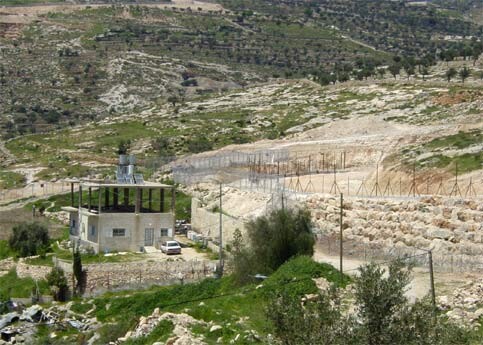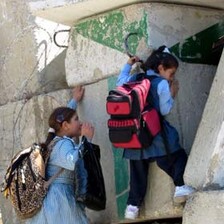The Electronic Intifada 16 November 2003

The path of the Wall next to a home in Bethlehem. (PENGON/Anti-Apartheid Wall Campaign)
BETHLEHEM
The wall around Bethlehem serves to isolate and annex the religious areas. Around Rachel’s Tomb and the Bilal Ibn Rabah Mosque, hundreds will be isolated between two walls, further strengthening Israeli control of historic, religious, and deeply significant places and strangling the city economically.
Mundher Elias al-Bandak
My family has been in Bethlehem for hundreds of years. I live where I work, I have a factory that makes school and wood and metal furniture, located about 120-150 meters from Rachel’s tomb. My father built this factory in 1936. At one point we had 120 workers here.
On 10 April 2002, I saw Israeli bulldozers on my property without prior notice. When I asked, I was shot at (warning shots). If you remember, Bethlehem and the manger were under siege at the time. They took advantage of the curfew and world focus on the manger crisis, and they used their bulldozers to seize people’s properties. I tried legal means to stop them but wasn’t successful. The road was developed and now it is 30 meters wide.
You cannot measure the psychological impact of the wall. You can’t capture it in words or images. Nor can you control it or be treated for it or push it away. This ghost never goes away, and it always controls your consciousness, even when you sleep, the nightmare grabs hold of you. When you are made to feel like an animal, confined by walls. More than 100 years ago countries created sanctuaries for animals that weren’t defined by walls. They tried to care for the animals in a humane way. They created preserves. How can people treat their fellow brothers in ways worse than animals are treated?
We are also economically negatively impacted. You can measure this in dunums or dollars, and you can easily find a solution for that. You can figure out the compensation. But the effect on morale and history, culture, civilization — these are things we can’t measure or compensate. How can we in the 21st century have walls that are 8 and 10 meters high and electric fences and plans that are hard to imagine?
The wall is going to be 25 meters away from my bedroom and about 6 meters away from my factory on 2 sides. Politically, the wall creates a huge problem as it tries to solve a small problem. The Israelis say they are concerned about security for those coming to pray at Rachel’s tomb, but since 1967 not a single person visiting Rachel’s tomb has ever been harmed.
We are still raising legal objections to the military order on the wall. We were able temporarily to stop implementation of the wall. The wall is inappropriate, inhumane, and illegal. We don’t need 8-meter high walls or fences unless one side has taken something from another side and doesn’t want to return it. If you have good relations, you can put an 80-cm wall of roses, and that’s enough of a geographic demarcation. If Israel is serious about good relations, it doesn’t need a wall.
My factory and home are in a border area. As such, we will always be subject to sudden unwanted visits. This wall will trigger a much bigger problem. We will be isolated even from Bethlehem. Who will be brave enough to visit me at home or come to the factory to buy my goods? I might be forced to close. How can I protect myself and protect what remains of my land?
BEIT JALA
Saleh Mohsen Sarhan
I live here with my family; I have 5 sons and 3 daughters and lots of grandkids. We are one family, about 39 people.
We faced many problems during the intifada from neighboring Gilo settlement for about 2 years. Both sides exchanged gunfire, and because we are on the borderline we got it from both sides. Sometimes we couldn’t make it out of our homes to go to Bethlehem or Beit Jala. This was hard on the children, and they have psychological problems, including fear and instability.
The Israelis started to dig trenches for the wall near our home. We lost 90 to 95 trees. Olive, almond, fig, apple, and peach trees. About 30 trees were Roman olives. They were uprooted. Part of the wall is an electric fence, with a trench separating two rolls of coil near our home. At present, the children can’t reach the fence because of the trenches, and we’re always afraid that they’ll fall in them and to the electric current.
We had a farm with two hatcheries, each with 1,000 hatching chickens. When they were digging their trenches the sound of the machinery affected the chickens. For 5 months, they didn’t lay eggs. Not a single egg. They had psychological problems. Each chicken cost 25 shekels, and those that didn’t die we sold for 1 shekel apiece. And these chickens had been a source of income for us. You know, an employee’s salary isn’t enough to support a family, you have to supplement it. We pay taxes to Israel (arnon) but we get nothing in return, except water. We have a well, but it was compromised by the machinery and explosives the Israelis were using.
They took about 6 dunums from us and started digging at least a year ago. They put the fence in 3-4 months ago; it is about 70 meters away from the house, and the electric current is running. We explained to the children that these are electric wire, and they understand that, they don’t go near it.
From the wall to the north, they made a dirt road, and patrol cars use it. On the other side, they made a road and paved it; it has traffic signs like a regular road, and there is an alternate route. And no one knows what this road is for and who will use it. Right now only patrols use it. Five or 6 trips a day, and when they get close to our homes they create disturbances. They honk at 1 or 2 am.
There is a watchtower near the homes. If we get anywhere near it, the watchtower contacts the Border Guard and a patrol comes by and starts to question us. We’re just standing on our own property. Why are you standing here? We say, this is our land and these are our homes. They start to talk to each other. It is annoying.
Interviews
Ida Audeh is a Palestinian from the West Bank who works as a technical writer in Boulder, CO. She went to the West Bank in August for three weeks to visit family and to learn more about the effect of the wall on the lives of ordinary people. She is the author of “Picking Olives and Removing Roadblocks as Acts of Resistance: An Interview with Ghassan Andoni” Counterpunch, 28 October 2002 and “Narratives of Siege: Eyewitness Testimonies from Jenin, Bethlehem, and Nablus,” Journal of Palestine Studies, no. 124 (Summer 2002).




